0450e-Application For Certification as a Welding Inspector 焊接检验员认证申请
a certificate error occurred -回复
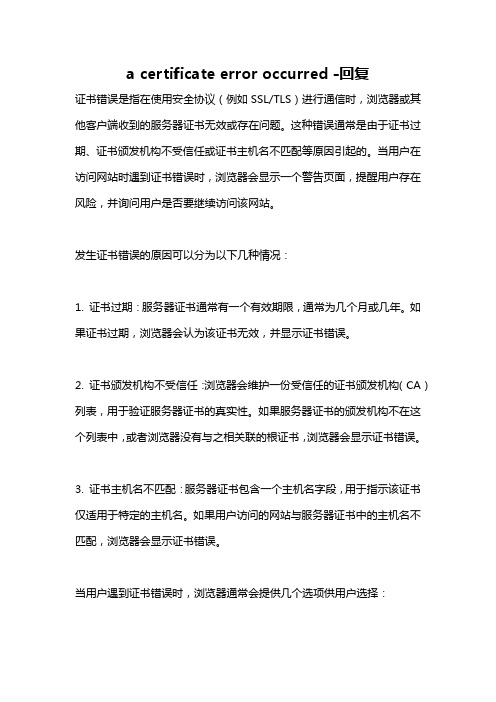
a certificate error occurred -回复证书错误是指在使用安全协议(例如SSL/TLS)进行通信时,浏览器或其他客户端收到的服务器证书无效或存在问题。
这种错误通常是由于证书过期、证书颁发机构不受信任或证书主机名不匹配等原因引起的。
当用户在访问网站时遇到证书错误时,浏览器会显示一个警告页面,提醒用户存在风险,并询问用户是否要继续访问该网站。
发生证书错误的原因可以分为以下几种情况:1. 证书过期:服务器证书通常有一个有效期限,通常为几个月或几年。
如果证书过期,浏览器会认为该证书无效,并显示证书错误。
2. 证书颁发机构不受信任:浏览器会维护一份受信任的证书颁发机构(CA)列表,用于验证服务器证书的真实性。
如果服务器证书的颁发机构不在这个列表中,或者浏览器没有与之相关联的根证书,浏览器会显示证书错误。
3. 证书主机名不匹配:服务器证书包含一个主机名字段,用于指示该证书仅适用于特定的主机名。
如果用户访问的网站与服务器证书中的主机名不匹配,浏览器会显示证书错误。
当用户遇到证书错误时,浏览器通常会提供几个选项供用户选择:1. 继续访问网站:如果用户选择继续访问网站,浏览器会继续建立与服务器的安全连接。
然而,这样做存在一定的风险,因为用户无法确定证书错误的具体原因。
2. 返回上一页:用户可以选择返回上一页,以避免继续访问可能存在风险的网站。
3. 查看证书详情:浏览器通常提供了查看证书详情的选项,以便用户了解证书的更多信息。
这些信息包括证书颁发机构、有效期限和主机名等。
要解决证书错误,可以采取以下几个步骤:1. 检查证书过期:首先,确保服务器证书的有效期限尚未过期。
如果过期,需要联系证书颁发机构重新颁发新的证书。
2. 验证证书颁发机构:确保服务器证书的颁发机构在浏览器的受信任列表中。
如果不在列表中,需要联系证书颁发机构获得受信任的证书。
3. 检查证书主机名:确认用户访问的网站与服务器证书中的主机名一致。
客户常见问题解答(FAQ)
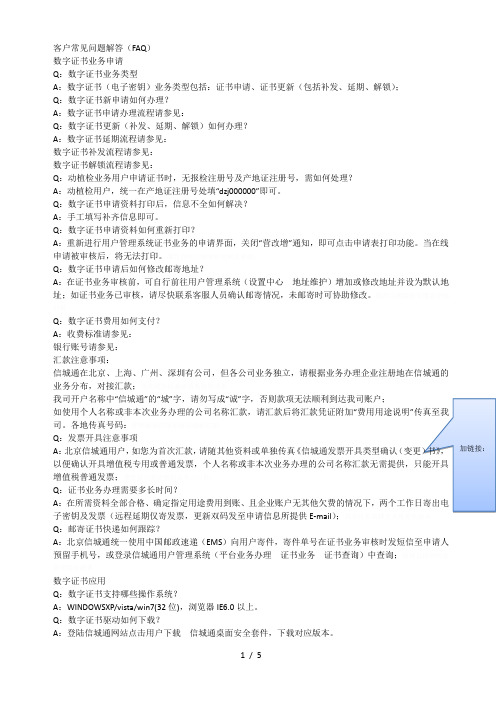
客户常见问题解答(FAQ )数字证书业务申请Q :数字证书业务类型A :数字证书(电子密钥)业务类型包括:证书申请、证书更新(包括补发、延期、解锁);Q :数字证书新申请如何办理?A :数字证书申请办理流程请参见:Q :数字证书更新(补发、延期、解锁)如何办理?A :数字证书延期流程请参见:数字证书补发流程请参见:数字证书解锁流程请参见:Q :动植检业务用户申请证书时,无报检注册号及产地证注册号,需如何处理?A :动植检用户,统一在产地证注册号处填“dzj000000”即可。
Q :数字证书申请资料打印后,信息不全如何解决?A :手工填写补齐信息即可。
Q :数字证书申请资料如何重新打印?A :重新进行用户管理系统证书业务的申请界面,关闭“营改增”通知,即可点击申请表打印功能。
当在线申请被审核后,将无法打印。
Q :数字证书申请后如何修改邮寄地址?A :在证书业务审核前,可自行前往用户管理系统(设置中心地址维护)增加或修改地址并设为默认地址;如证书业务已审核,请尽快联系客服人员确认邮寄情况,未邮寄时可协助修改。
Q :数字证书费用如何支付?A :收费标准请参见:银行账号请参见:汇款注意事项:信城通在北京、上海、广州、深圳有公司,但各公司业务独立,请根据业务办理企业注册地在信城通的业务分布,对接汇款;我司开户名称中“信城通”的“城”字,请勿写成“诚”字,否则款项无法顺利到达我司账户;如使用个人名称或非本次业务办理的公司名称汇款,请汇款后将汇款凭证附加“费用用途说明”司。
各地传真号码:Q :发票开具注意事项A :北京信城通用户,如您为首次汇款,请随其他资料或单独传真《信城通发票开具类型确认增值税普通发票;Q :证书业务办理需要多长时间?A 子密钥及发票(远程延期仅寄发票,更新双码发至申请信息所提供E-mail );Q :邮寄证书快递如何跟踪?A :北京信城通统一使用中国邮政速递(EMS )向用户寄件,寄件单号在证书业务审核时发短信至申请人预留手机号,或登录信城通用户管理系统(平台业务办理证书业务证书查询)中查询;数字证书应用Q :数字证书支持哪些操作系统?A :WINDOWSXP/vista/win7(32位),浏览器IE6.0以上。
怎样申请MCT证书成为微软认证

以下是根据⼴⼤学员咨询的怎么申请成为⼀个合格的微软认证获得MCT证书的要求和步骤,任何在微软相关技术和演讲⽅⾯有⼀定能⼒和兴趣的⼈员都有机会成为微软认证(MCT)。
如果您⼀直致⼒于研究或使⽤微软产品和解决⽅案、拥有相当的实际经验并具备良好的表达能⼒和整体形象,您可以按照以下5步完成微软认证(以下简称MCT)的申请。
第1步:获得微软认证专家(MCP)或微软商业解决⽅案(MBS)资格证书 根据微软公司全球统⼀标准,在申请成为 MCT 之前,您必须获得下列证书之⼀。
此项标准的⽬的是为了核实 MCT申请者具备经过证实的技术实⼒和教学⼯作能⼒。
⼀旦获得某项微软认证,即表明您已经在与您的证书相关的领域或⼯作岗位中展⽰了您运⽤微软产品和技术开展⼯作的熟练程度。
Microsoft Certified Desktop Support Techniciann (MCDST) Microsoft Certified Systems Administrator (MCSA) on Microsoftn Windows 2000 Microsoft Certified Systems Administrator (MCSA) on Microsoftn Windows Server 2003 Microsoft Certified Systems Engineer (MCSE) onn Microsoft Windows 2000 Microsoft Certified Systems Engineer (MCSE) onn Microsoft Windows Server 2003 Microsoft Certified Application Developern (MCAD) for Microsoft .NET Microsoft Certified Professional Developern (MCPD) Microsoft Certified Solution Developer (MCSD) on Visual Studion 6.0 Microsoft Certified Solution Developer (MCSD) for Microsoft .NETn n Microsoft Certified Database Administrator (MCDBA) on Microsoft SQL Server 2000 Microsoft Certified IT Professional (MCITP)n Microsoft Officen Specialist (MOS) – pass at least one of the following exams: • Word 2003 Expert • Excel 2003 Expert • PowerPoint 2003 • Access 2003 • Outlook 2003 Microsoft Certifiedn Application Specialist – pass at least one of the following exams: • Exam 70-601: Using Microsoft Office Word 2007 • Exam 70-602: Using Microsoft Office Excel 2007 • Exam 70-603: Using Microsoft Office PowerPoint 2007 • Exam 70-604: Using Microsoft Office Outlook 2007 • Exam 70-605: Using Microsoft Office Access 2007 • Exam 70-600: Using Microsoft Windows Vista Microsoft Certifiedn Professional: Exam 70-301, Managing, Organizing, and Delivering IT Projects by Using the Microsoft Solutions Framework Microsoft Certified Businessn Management Solutions Professional – Application for Microsoft Dynamics GP Microsoft Certified Business Management Solutions Professional – Installation & Configuration for Microsoft Dynamics GP Microsoft Certified Businessn Management Solutions Professional – Application for Microsoft Dynamics SL Microsoft Certified Business Management Solutions Professional – Installation & Configuration for Microsoft Dynamics SL Microsoft Certified Businessn Management Solutions Professional – Application for Microsoft Dynamics CRM Microsoft Certified Business Management Solutions Professional – Installation & Configuration for Microsoft Dynamics CRM Microsoft Certifiedn Business Management Solutions Professional – Developer for Microsoft Dynamics CRM Microsoft Certified Business Management Solutions Professional –n Application for Microsoft Dynamics NAV Microsoft Certified Businessn Management Solutions Professional – Installation & Configuration for Microsoft Dynamics NAV Microsoft Certified Business Management Solutionsn Professional – Developer for Microsoft Dynamics NAV Microsoft Certifiedn Business Management Solutions Professional – Application for Microsoft Dynamics AX Microsoft Certified Business Management Solutions Professional –n Installation & Configuration for Microsoft Dynamics AX Microsoftn Certified Business Management Solutions Professional—Developer for Microsoft Dynamics AX Microsoft Retail Management System MCT Designationn。
401 502 成分

401 502 成分
摘要:
1.401 和502 的含义
2.401 和502 的成分
正文:
401 和502 是指网络状态码,它们分别代表不同的含义。
401 代表的是未授权,即请求未包含有效的身份验证凭据,服务器无法处理该请求。
而502 则代表的是错误网关,即服务器作为网关或代理时,从上游服务器收到无效的响应。
在了解了这两个状态码的含义后,我们来看看它们的成分。
首先,401 状态码的成分主要包括:
1.请求头中的Authorization 字段:该字段用于携带身份验证凭据,如果请求中缺少这个字段或者携带的凭据无效,服务器就会返回401 状态码。
2.服务器的认证机制:服务器需要实现认证机制,对请求进行身份验证,如果验证失败,就会返回401 状态码。
接下来,502 状态码的成分主要包括:
1.请求头中的相关信息:当服务器作为网关或代理时,它会收到来自上游服务器的响应,如果响应无效,服务器就会返回502 状态码。
这些响应可能包括HTTP 状态码、响应头和响应体等信息。
2.服务器对响应的解析和处理:服务器需要对收到的响应进行解析和处理,如果发现响应无效,就会返回502 状态码。
总结来说,401 和502 状态码分别代表了不同的网络问题,它们的成分也各不相同。
远博电子认证证书安装操作指南
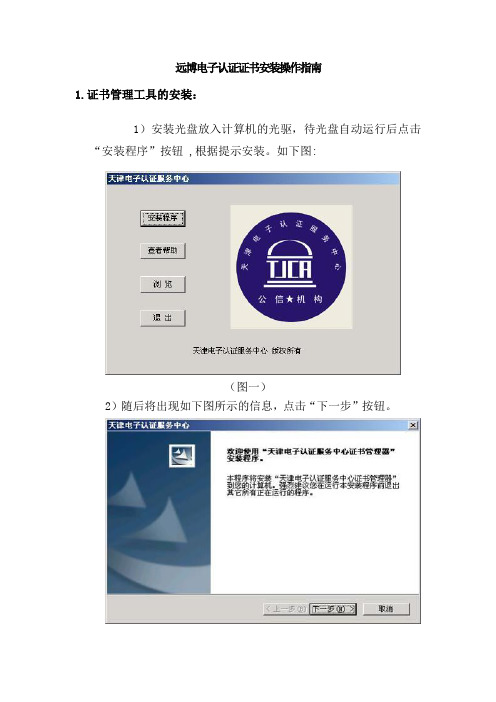
远博电子认证证书安装操作指南
1.证书管理工具的安装:
1)安装光盘放入计算机的光驱,待光盘自动运行后点击“安装程序”按钮 ,根据提示安装。
如下图:
(图一)
2)随后将出现如下图所示的信息,点击“下一步”按钮。
(图二)
3)点击“完成”按钮,结束安装
(图三)
2.安装出现的问题:
1)ikernel错误缺乏必要的系统文件
答:(1)删除engine文件夹;(2)安全模式安装;(3)覆盖系统文件;(4)更换机器安装。
2)屏幕右下角未出现证书管理器图标。
如下图
(图四)
答:点击“开始”→“程序”→“天津电子认证服务中心”→“证书管理器”。
若没有此项,需重新安装与证书相对应的证书管理工具。
3)证书安装后左键单击屏幕右下角证书管理器图标,再单击其中“密码”和“证书”菜单,其内选项为灰色。
答:首先查看E-key上的指示灯是否闪亮,如果不亮,可更换其机器上的USB插口,如还不亮,需携带E-key到天津电子认证服务中心进行检测。
如果闪亮:
(1)可以使用延长线或是选择其他USB插口插入重试;
(2)可以重新安装证书管理工具。
4)显示“请选择读卡器”
答:与其他数字证书工具软件冲突,应将相冲突的软件分别安装在不同系统中或不同电脑上。
5)安装证书管理工具的时候,出现“是否要完全删除所选应用程序及其所有组件?”的提示窗口。
答:说明电脑中已经装有证书管理工具,如想删除后重新安装,可先将屏幕右下角管理器图标点击右键选择退出后再进行删除。
6)如果卸载时出现“检测到锁定文件”时如何操作。
答:应在卸载完成后,重新启动计算机后再安装。
certificate of declaration -回复
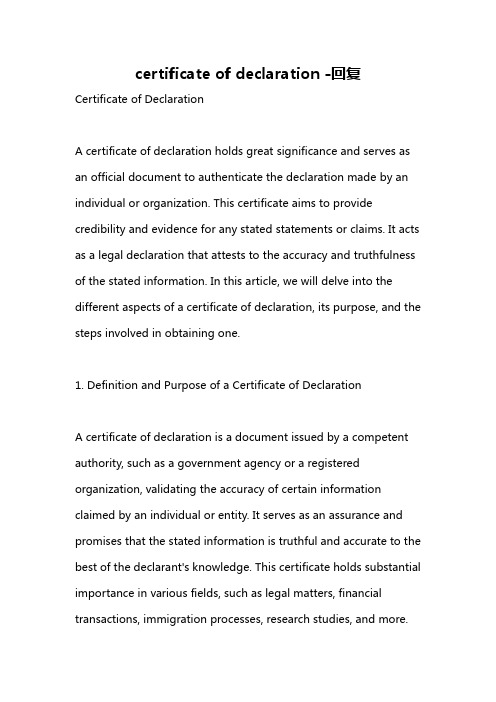
certificate of declaration -回复Certificate of DeclarationA certificate of declaration holds great significance and serves as an official document to authenticate the declaration made by an individual or organization. This certificate aims to provide credibility and evidence for any stated statements or claims. It acts as a legal declaration that attests to the accuracy and truthfulness of the stated information. In this article, we will delve into the different aspects of a certificate of declaration, its purpose, and the steps involved in obtaining one.1. Definition and Purpose of a Certificate of DeclarationA certificate of declaration is a document issued by a competent authority, such as a government agency or a registered organization, validating the accuracy of certain information claimed by an individual or entity. It serves as an assurance and promises that the stated information is truthful and accurate to the best of the declarant's knowledge. This certificate holds substantial importance in various fields, such as legal matters, financial transactions, immigration processes, research studies, and more.2. Contents and Structure of a Certificate of Declaration.Typically, a certificate of declaration comprises several key elements that must be included to ensure its validity and relevance. These elements may vary based on the purpose and requirements of the certified declaration. Some of the common contents include:a) Title: The document should be titled "Certificate of Declaration" or a similar term to capture the essence of the statement being certified.b) Declarant's information: The certificate should clearly state the name, address, contact details, and any relevant identification number of the individual or organization making the declaration.c) Statement of the declaration: A precise and explicit statement must be included, presenting the information that is being declared as truthful and accurate. It should clearly outline the facts or claims being attested.d) Supporting evidence: In some cases, the certificate may requirethe inclusion of supporting evidence or documents to validate the declaration being made. These attachments should be clearly identified and referenced within the certificate.e) Authority or notary: The certificate must carry the signature, name, and title of the authorized person or notary who is certifying the document. This ensures the credibility and validity of the declaration.f) Date and place: The date and place of issuance must be mentioned to establish the timing and jurisdiction of the declaration.3. Steps Involved in Obtaining a Certificate of DeclarationThe process of obtaining a certificate of declaration involves several crucial steps:Step 1: Identify the need for a declaration certificate - Determine the purpose and importance of the certificate. Understanding the specific requirements will help in crafting the precise statement within the document.Step 2: Research the competent authority - Identify the appropriate authority or organization authorized to issue the certificate. This may involve consulting legal professionals, government agencies, or relevant entities.Step 3: Gather accurate information - Compile all necessary facts and data that accurately reflect the claims or statements being made. Ensure that supporting evidence, if required, is obtained and properly referenced.Step 4: Draft the declaration - Create a clear and concise statement that reflects the information accurately and truthfully. The language used should be precise and unambiguous.Step 5: Submit the declaration - Provide the drafted declaration to the competent authority for review and certification. Follow any specific procedures or requirements provided by the authority, such as completing application forms or paying certain fees.Step 6: Review and confirmation - The competent authority will review the declaration, verifying its accuracy and completeness. Ifsatisfied, they will issue the certificate of declaration, which will include the authorized signature and stamp.Step 7: Maintain and secure the certificate - Once obtained, the certificate must be stored securely to avoid any alteration or tampering. It should be readily available when needed for legal or official purposes.In conclusion, a certificate of declaration holds immense value in legal, financial, or official matters. It serves as a testament to the truthfulness and accuracy of the stated information, providing essential credibility and evidence. Understanding the purpose, structure, and steps involved in obtaining such a certificate is crucial to ensure compliance and authenticity in any declaration made.。
EAL4+级认证申请附件基本要求
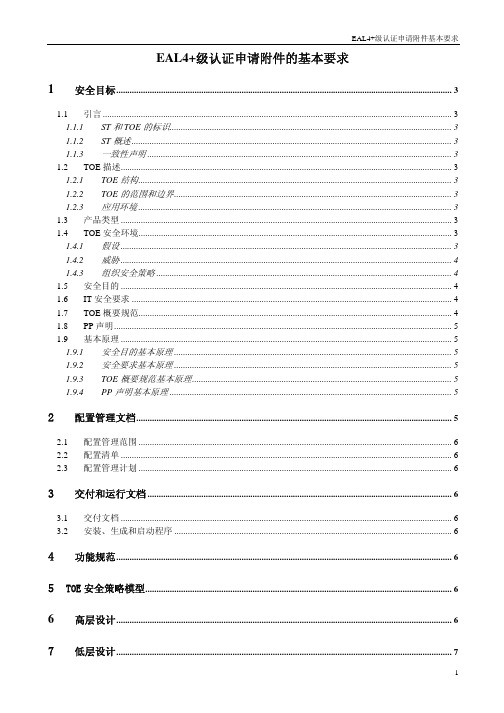
EAL4+级认证申请附件的基本要求1安全目标 (3)1.1 引言 (3)1.1.1ST和TOE的标识 (3)1.1.2ST概述 (3)1.1.3一致性声明 (3)1.2 TOE描述 (3)1.2.1TOE结构 (3)1.2.2TOE的范围和边界 (3)1.2.3应用环境 (3)1.3 产品类型 (3)1.4 TOE安全环境 (3)1.4.1假设 (3)1.4.2威胁 (4)1.4.3组织安全策略 (4)1.5 安全目的 (4)1.6 IT安全要求 (4)1.7 TOE概要规范 (4)1.8 PP声明 (5)1.9 基本原理 (5)1.9.1安全目的基本原理 (5)1.9.2安全要求基本原理 (5)1.9.3TOE概要规范基本原理 (5)1.9.4PP声明基本原理 (5)2配置管理文档 (5)2.1 配置管理范围 (6)2.2 配置清单 (6)2.3 配置管理计划 (6)3交付和运行文档 (6)3.1 交付文档 (6)3.2 安装、生成和启动程序 (6)4功能规范 (6)5TOE安全策略模型 (6)6高层设计 (6)7低层设计 (7)8实现表示文档 (7)9模块化 (7)10开发活动的对应性分析文档 (7)11指导性文档 (7)11.1用户指南 (7)11.2 管理员指南 (8)12测试相关文档 (8)12.1 测试文档 (8)12.2 测试范围分析 (8)12.3 测试深度分析 (8)13生命周期支持相关文档 (8)13.1 开发安全文档 (8)13.2 生命周期模型 (8)13.3 开发工具文档 (8)14脆弱性分析 (8)14.1 误用 (8)14.2 TOE安全功能强度 (9)14.3 脆弱性分析 (9)15质量保证体系文件 (9)15.1 文件控制程序 (9)15.2 过程控制 (9)15.3 质量检测报告 (9)15.4 资源管理 (9)15.5 记录控制 (9)15.6 不合格品控制 (9)15.7 质量手册 (10)15.8 管理评审、内审 (10)15.9 采购控制 (10)15.10 纠正和预防程序 (10)15.11 服务过程控制 (10)1安全目标申请者提供的文档《安全目标》(《安全目标》编写方法参见《PP和ST产生指南》)应包括如下内容:1.1 引言1.1.1 ST和TOE的标识1)包括ST标识信息,如ST标题、版本号、出版日期和作者;2)包括TOE标识信息,如TOE名称、TOE版本号;3)包括开发此ST所依据的CC或PP的标识信息:CC版本号,PP名称、版本号和出版日期。
OSHA现场作业手册说明书
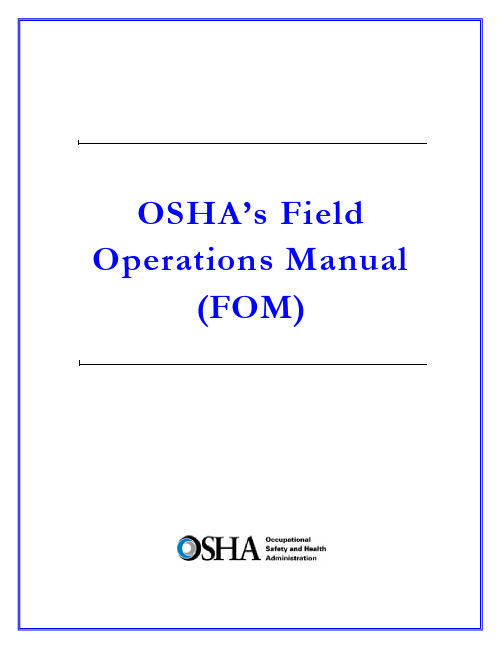
DIRECTIVE NUMBER: CPL 02-00-150 EFFECTIVE DATE: April 22, 2011 SUBJECT: Field Operations Manual (FOM)ABSTRACTPurpose: This instruction cancels and replaces OSHA Instruction CPL 02-00-148,Field Operations Manual (FOM), issued November 9, 2009, whichreplaced the September 26, 1994 Instruction that implemented the FieldInspection Reference Manual (FIRM). The FOM is a revision of OSHA’senforcement policies and procedures manual that provides the field officesa reference document for identifying the responsibilities associated withthe majority of their inspection duties. This Instruction also cancels OSHAInstruction FAP 01-00-003 Federal Agency Safety and Health Programs,May 17, 1996 and Chapter 13 of OSHA Instruction CPL 02-00-045,Revised Field Operations Manual, June 15, 1989.Scope: OSHA-wide.References: Title 29 Code of Federal Regulations §1903.6, Advance Notice ofInspections; 29 Code of Federal Regulations §1903.14, Policy RegardingEmployee Rescue Activities; 29 Code of Federal Regulations §1903.19,Abatement Verification; 29 Code of Federal Regulations §1904.39,Reporting Fatalities and Multiple Hospitalizations to OSHA; and Housingfor Agricultural Workers: Final Rule, Federal Register, March 4, 1980 (45FR 14180).Cancellations: OSHA Instruction CPL 02-00-148, Field Operations Manual, November9, 2009.OSHA Instruction FAP 01-00-003, Federal Agency Safety and HealthPrograms, May 17, 1996.Chapter 13 of OSHA Instruction CPL 02-00-045, Revised FieldOperations Manual, June 15, 1989.State Impact: Notice of Intent and Adoption required. See paragraph VI.Action Offices: National, Regional, and Area OfficesOriginating Office: Directorate of Enforcement Programs Contact: Directorate of Enforcement ProgramsOffice of General Industry Enforcement200 Constitution Avenue, NW, N3 119Washington, DC 20210202-693-1850By and Under the Authority ofDavid Michaels, PhD, MPHAssistant SecretaryExecutive SummaryThis instruction cancels and replaces OSHA Instruction CPL 02-00-148, Field Operations Manual (FOM), issued November 9, 2009. The one remaining part of the prior Field Operations Manual, the chapter on Disclosure, will be added at a later date. This Instruction also cancels OSHA Instruction FAP 01-00-003 Federal Agency Safety and Health Programs, May 17, 1996 and Chapter 13 of OSHA Instruction CPL 02-00-045, Revised Field Operations Manual, June 15, 1989. This Instruction constitutes OSHA’s general enforcement policies and procedures manual for use by the field offices in conducting inspections, issuing citations and proposing penalties.Significant Changes∙A new Table of Contents for the entire FOM is added.∙ A new References section for the entire FOM is added∙ A new Cancellations section for the entire FOM is added.∙Adds a Maritime Industry Sector to Section III of Chapter 10, Industry Sectors.∙Revises sections referring to the Enhanced Enforcement Program (EEP) replacing the information with the Severe Violator Enforcement Program (SVEP).∙Adds Chapter 13, Federal Agency Field Activities.∙Cancels OSHA Instruction FAP 01-00-003, Federal Agency Safety and Health Programs, May 17, 1996.DisclaimerThis manual is intended to provide instruction regarding some of the internal operations of the Occupational Safety and Health Administration (OSHA), and is solely for the benefit of the Government. No duties, rights, or benefits, substantive or procedural, are created or implied by this manual. The contents of this manual are not enforceable by any person or entity against the Department of Labor or the United States. Statements which reflect current Occupational Safety and Health Review Commission or court precedents do not necessarily indicate acquiescence with those precedents.Table of ContentsCHAPTER 1INTRODUCTIONI.PURPOSE. ........................................................................................................... 1-1 II.SCOPE. ................................................................................................................ 1-1 III.REFERENCES .................................................................................................... 1-1 IV.CANCELLATIONS............................................................................................. 1-8 V. ACTION INFORMATION ................................................................................. 1-8A.R ESPONSIBLE O FFICE.......................................................................................................................................... 1-8B.A CTION O FFICES. .................................................................................................................... 1-8C. I NFORMATION O FFICES............................................................................................................ 1-8 VI. STATE IMPACT. ................................................................................................ 1-8 VII.SIGNIFICANT CHANGES. ............................................................................... 1-9 VIII.BACKGROUND. ................................................................................................. 1-9 IX. DEFINITIONS AND TERMINOLOGY. ........................................................ 1-10A.T HE A CT................................................................................................................................................................. 1-10B. C OMPLIANCE S AFETY AND H EALTH O FFICER (CSHO). ...........................................................1-10B.H E/S HE AND H IS/H ERS ..................................................................................................................................... 1-10C.P ROFESSIONAL J UDGMENT............................................................................................................................... 1-10E. W ORKPLACE AND W ORKSITE ......................................................................................................................... 1-10CHAPTER 2PROGRAM PLANNINGI.INTRODUCTION ............................................................................................... 2-1 II.AREA OFFICE RESPONSIBILITIES. .............................................................. 2-1A.P ROVIDING A SSISTANCE TO S MALL E MPLOYERS. ...................................................................................... 2-1B.A REA O FFICE O UTREACH P ROGRAM. ............................................................................................................. 2-1C. R ESPONDING TO R EQUESTS FOR A SSISTANCE. ............................................................................................ 2-2 III. OSHA COOPERATIVE PROGRAMS OVERVIEW. ...................................... 2-2A.V OLUNTARY P ROTECTION P ROGRAM (VPP). ........................................................................... 2-2B.O NSITE C ONSULTATION P ROGRAM. ................................................................................................................ 2-2C.S TRATEGIC P ARTNERSHIPS................................................................................................................................. 2-3D.A LLIANCE P ROGRAM ........................................................................................................................................... 2-3 IV. ENFORCEMENT PROGRAM SCHEDULING. ................................................ 2-4A.G ENERAL ................................................................................................................................................................. 2-4B.I NSPECTION P RIORITY C RITERIA. ..................................................................................................................... 2-4C.E FFECT OF C ONTEST ............................................................................................................................................ 2-5D.E NFORCEMENT E XEMPTIONS AND L IMITATIONS. ....................................................................................... 2-6E.P REEMPTION BY A NOTHER F EDERAL A GENCY ........................................................................................... 2-6F.U NITED S TATES P OSTAL S ERVICE. .................................................................................................................. 2-7G.H OME-B ASED W ORKSITES. ................................................................................................................................ 2-8H.I NSPECTION/I NVESTIGATION T YPES. ............................................................................................................... 2-8 V.UNPROGRAMMED ACTIVITY – HAZARD EVALUATION AND INSPECTION SCHEDULING ............................................................................ 2-9 VI.PROGRAMMED INSPECTIONS. ................................................................... 2-10A.S ITE-S PECIFIC T ARGETING (SST) P ROGRAM. ............................................................................................. 2-10B.S CHEDULING FOR C ONSTRUCTION I NSPECTIONS. ..................................................................................... 2-10C.S CHEDULING FOR M ARITIME I NSPECTIONS. ............................................................................. 2-11D.S PECIAL E MPHASIS P ROGRAMS (SEP S). ................................................................................... 2-12E.N ATIONAL E MPHASIS P ROGRAMS (NEP S) ............................................................................... 2-13F.L OCAL E MPHASIS P ROGRAMS (LEP S) AND R EGIONAL E MPHASIS P ROGRAMS (REP S) ............ 2-13G.O THER S PECIAL P ROGRAMS. ............................................................................................................................ 2-13H.I NSPECTION S CHEDULING AND I NTERFACE WITH C OOPERATIVE P ROGRAM P ARTICIPANTS ....... 2-13CHAPTER 3INSPECTION PROCEDURESI.INSPECTION PREPARATION. .......................................................................... 3-1 II.INSPECTION PLANNING. .................................................................................. 3-1A.R EVIEW OF I NSPECTION H ISTORY .................................................................................................................... 3-1B.R EVIEW OF C OOPERATIVE P ROGRAM P ARTICIPATION .............................................................................. 3-1C.OSHA D ATA I NITIATIVE (ODI) D ATA R EVIEW .......................................................................................... 3-2D.S AFETY AND H EALTH I SSUES R ELATING TO CSHO S.................................................................. 3-2E.A DVANCE N OTICE. ................................................................................................................................................ 3-3F.P RE-I NSPECTION C OMPULSORY P ROCESS ...................................................................................................... 3-5G.P ERSONAL S ECURITY C LEARANCE. ................................................................................................................. 3-5H.E XPERT A SSISTANCE. ........................................................................................................................................... 3-5 III. INSPECTION SCOPE. ......................................................................................... 3-6A.C OMPREHENSIVE ................................................................................................................................................... 3-6B.P ARTIAL. ................................................................................................................................................................... 3-6 IV. CONDUCT OF INSPECTION .............................................................................. 3-6A.T IME OF I NSPECTION............................................................................................................................................. 3-6B.P RESENTING C REDENTIALS. ............................................................................................................................... 3-6C.R EFUSAL TO P ERMIT I NSPECTION AND I NTERFERENCE ............................................................................. 3-7D.E MPLOYEE P ARTICIPATION. ............................................................................................................................... 3-9E.R ELEASE FOR E NTRY ............................................................................................................................................ 3-9F.B ANKRUPT OR O UT OF B USINESS. .................................................................................................................... 3-9G.E MPLOYEE R ESPONSIBILITIES. ................................................................................................. 3-10H.S TRIKE OR L ABOR D ISPUTE ............................................................................................................................. 3-10I. V ARIANCES. .......................................................................................................................................................... 3-11 V. OPENING CONFERENCE. ................................................................................ 3-11A.G ENERAL ................................................................................................................................................................ 3-11B.R EVIEW OF A PPROPRIATION A CT E XEMPTIONS AND L IMITATION. ..................................................... 3-13C.R EVIEW S CREENING FOR P ROCESS S AFETY M ANAGEMENT (PSM) C OVERAGE............................. 3-13D.R EVIEW OF V OLUNTARY C OMPLIANCE P ROGRAMS. ................................................................................ 3-14E.D ISRUPTIVE C ONDUCT. ...................................................................................................................................... 3-15F.C LASSIFIED A REAS ............................................................................................................................................. 3-16VI. REVIEW OF RECORDS. ................................................................................... 3-16A.I NJURY AND I LLNESS R ECORDS...................................................................................................................... 3-16B.R ECORDING C RITERIA. ...................................................................................................................................... 3-18C. R ECORDKEEPING D EFICIENCIES. .................................................................................................................. 3-18 VII. WALKAROUND INSPECTION. ....................................................................... 3-19A.W ALKAROUND R EPRESENTATIVES ............................................................................................................... 3-19B.E VALUATION OF S AFETY AND H EALTH M ANAGEMENT S YSTEM. ....................................................... 3-20C.R ECORD A LL F ACTS P ERTINENT TO A V IOLATION. ................................................................................. 3-20D.T ESTIFYING IN H EARINGS ................................................................................................................................ 3-21E.T RADE S ECRETS. ................................................................................................................................................. 3-21F.C OLLECTING S AMPLES. ..................................................................................................................................... 3-22G.P HOTOGRAPHS AND V IDEOTAPES.................................................................................................................. 3-22H.V IOLATIONS OF O THER L AWS. ....................................................................................................................... 3-23I.I NTERVIEWS OF N ON-M ANAGERIAL E MPLOYEES .................................................................................... 3-23J.M ULTI-E MPLOYER W ORKSITES ..................................................................................................................... 3-27 K.A DMINISTRATIVE S UBPOENA.......................................................................................................................... 3-27 L.E MPLOYER A BATEMENT A SSISTANCE. ........................................................................................................ 3-27 VIII. CLOSING CONFERENCE. .............................................................................. 3-28A.P ARTICIPANTS. ..................................................................................................................................................... 3-28B.D ISCUSSION I TEMS. ............................................................................................................................................ 3-28C.A DVICE TO A TTENDEES .................................................................................................................................... 3-29D.P ENALTIES............................................................................................................................................................. 3-30E.F EASIBLE A DMINISTRATIVE, W ORK P RACTICE AND E NGINEERING C ONTROLS. ............................ 3-30F.R EDUCING E MPLOYEE E XPOSURE. ................................................................................................................ 3-32G.A BATEMENT V ERIFICATION. ........................................................................................................................... 3-32H.E MPLOYEE D ISCRIMINATION .......................................................................................................................... 3-33 IX. SPECIAL INSPECTION PROCEDURES. ...................................................... 3-33A.F OLLOW-UP AND M ONITORING I NSPECTIONS............................................................................................ 3-33B.C ONSTRUCTION I NSPECTIONS ......................................................................................................................... 3-34C. F EDERAL A GENCY I NSPECTIONS. ................................................................................................................. 3-35CHAPTER 4VIOLATIONSI. BASIS OF VIOLATIONS ..................................................................................... 4-1A.S TANDARDS AND R EGULATIONS. .................................................................................................................... 4-1B.E MPLOYEE E XPOSURE. ........................................................................................................................................ 4-3C.R EGULATORY R EQUIREMENTS. ........................................................................................................................ 4-6D.H AZARD C OMMUNICATION. .............................................................................................................................. 4-6E. E MPLOYER/E MPLOYEE R ESPONSIBILITIES ................................................................................................... 4-6 II. SERIOUS VIOLATIONS. .................................................................................... 4-8A.S ECTION 17(K). ......................................................................................................................... 4-8B.E STABLISHING S ERIOUS V IOLATIONS ............................................................................................................ 4-8C. F OUR S TEPS TO BE D OCUMENTED. ................................................................................................................... 4-8 III. GENERAL DUTY REQUIREMENTS ............................................................. 4-14A.E VALUATION OF G ENERAL D UTY R EQUIREMENTS ................................................................................. 4-14B.E LEMENTS OF A G ENERAL D UTY R EQUIREMENT V IOLATION.............................................................. 4-14C. U SE OF THE G ENERAL D UTY C LAUSE ........................................................................................................ 4-23D.L IMITATIONS OF U SE OF THE G ENERAL D UTY C LAUSE. ..............................................................E.C LASSIFICATION OF V IOLATIONS C ITED U NDER THE G ENERAL D UTY C LAUSE. ..................F. P ROCEDURES FOR I MPLEMENTATION OF S ECTION 5(A)(1) E NFORCEMENT ............................ 4-25 4-27 4-27IV.OTHER-THAN-SERIOUS VIOLATIONS ............................................... 4-28 V.WILLFUL VIOLATIONS. ......................................................................... 4-28A.I NTENTIONAL D ISREGARD V IOLATIONS. ..........................................................................................4-28B.P LAIN I NDIFFERENCE V IOLATIONS. ...................................................................................................4-29 VI. CRIMINAL/WILLFUL VIOLATIONS. ................................................... 4-30A.A REA D IRECTOR C OORDINATION ....................................................................................................... 4-31B.C RITERIA FOR I NVESTIGATING P OSSIBLE C RIMINAL/W ILLFUL V IOLATIONS ........................ 4-31C. W ILLFUL V IOLATIONS R ELATED TO A F ATALITY .......................................................................... 4-32 VII. REPEATED VIOLATIONS. ...................................................................... 4-32A.F EDERAL AND S TATE P LAN V IOLATIONS. ........................................................................................4-32B.I DENTICAL S TANDARDS. .......................................................................................................................4-32C.D IFFERENT S TANDARDS. .......................................................................................................................4-33D.O BTAINING I NSPECTION H ISTORY. .....................................................................................................4-33E.T IME L IMITATIONS..................................................................................................................................4-34F.R EPEATED V. F AILURE TO A BATE....................................................................................................... 4-34G. A REA D IRECTOR R ESPONSIBILITIES. .............................................................................. 4-35 VIII. DE MINIMIS CONDITIONS. ................................................................... 4-36A.C RITERIA ................................................................................................................................................... 4-36B.P ROFESSIONAL J UDGMENT. ..................................................................................................................4-37C. A REA D IRECTOR R ESPONSIBILITIES. .............................................................................. 4-37 IX. CITING IN THE ALTERNATIVE ............................................................ 4-37 X. COMBINING AND GROUPING VIOLATIONS. ................................... 4-37A.C OMBINING. ..............................................................................................................................................4-37B.G ROUPING. ................................................................................................................................................4-38C. W HEN N OT TO G ROUP OR C OMBINE. ................................................................................................4-38 XI. HEALTH STANDARD VIOLATIONS ....................................................... 4-39A.C ITATION OF V ENTILATION S TANDARDS ......................................................................................... 4-39B.V IOLATIONS OF THE N OISE S TANDARD. ...........................................................................................4-40 XII. VIOLATIONS OF THE RESPIRATORY PROTECTION STANDARD(§1910.134). ....................................................................................................... XIII. VIOLATIONS OF AIR CONTAMINANT STANDARDS (§1910.1000) ... 4-43 4-43A.R EQUIREMENTS UNDER THE STANDARD: .................................................................................................. 4-43B.C LASSIFICATION OF V IOLATIONS OF A IR C ONTAMINANT S TANDARDS. ......................................... 4-43 XIV. CITING IMPROPER PERSONAL HYGIENE PRACTICES. ................... 4-45A.I NGESTION H AZARDS. .................................................................................................................................... 4-45B.A BSORPTION H AZARDS. ................................................................................................................................ 4-46C.W IPE S AMPLING. ............................................................................................................................................. 4-46D.C ITATION P OLICY ............................................................................................................................................ 4-46 XV. BIOLOGICAL MONITORING. ...................................................................... 4-47CHAPTER 5CASE FILE PREPARATION AND DOCUMENTATIONI.INTRODUCTION ............................................................................................... 5-1 II.INSPECTION CONDUCTED, CITATIONS BEING ISSUED. .................... 5-1A.OSHA-1 ................................................................................................................................... 5-1B.OSHA-1A. ............................................................................................................................... 5-1C. OSHA-1B. ................................................................................................................................ 5-2 III.INSPECTION CONDUCTED BUT NO CITATIONS ISSUED .................... 5-5 IV.NO INSPECTION ............................................................................................... 5-5 V. HEALTH INSPECTIONS. ................................................................................. 5-6A.D OCUMENT P OTENTIAL E XPOSURE. ............................................................................................................... 5-6B.E MPLOYER’S O CCUPATIONAL S AFETY AND H EALTH S YSTEM. ............................................................. 5-6 VI. AFFIRMATIVE DEFENSES............................................................................. 5-8A.B URDEN OF P ROOF. .............................................................................................................................................. 5-8B.E XPLANATIONS. ..................................................................................................................................................... 5-8 VII. INTERVIEW STATEMENTS. ........................................................................ 5-10A.G ENERALLY. ......................................................................................................................................................... 5-10B.CSHO S SHALL OBTAIN WRITTEN STATEMENTS WHEN: .......................................................................... 5-10C.L ANGUAGE AND W ORDING OF S TATEMENT. ............................................................................................. 5-11D.R EFUSAL TO S IGN S TATEMENT ...................................................................................................................... 5-11E.V IDEO AND A UDIOTAPED S TATEMENTS. ..................................................................................................... 5-11F.A DMINISTRATIVE D EPOSITIONS. .............................................................................................5-11 VIII. PAPERWORK AND WRITTEN PROGRAM REQUIREMENTS. .......... 5-12 IX.GUIDELINES FOR CASE FILE DOCUMENTATION FOR USE WITH VIDEOTAPES AND AUDIOTAPES .............................................................. 5-12 X.CASE FILE ACTIVITY DIARY SHEET. ..................................................... 5-12 XI. CITATIONS. ..................................................................................................... 5-12A.S TATUTE OF L IMITATIONS. .............................................................................................................................. 5-13B.I SSUING C ITATIONS. ........................................................................................................................................... 5-13C.A MENDING/W ITHDRAWING C ITATIONS AND N OTIFICATION OF P ENALTIES. .................................. 5-13D.P ROCEDURES FOR A MENDING OR W ITHDRAWING C ITATIONS ............................................................ 5-14 XII. INSPECTION RECORDS. ............................................................................... 5-15A.G ENERALLY. ......................................................................................................................................................... 5-15B.R ELEASE OF I NSPECTION I NFORMATION ..................................................................................................... 5-15C. C LASSIFIED AND T RADE S ECRET I NFORMATION ...................................................................................... 5-16。
certificationrequest参数

certificationrequest参数在许多网络通信和安全协议中,certificationrequest参数是一个重要的组成部分。
它主要用于在客户端向服务器端请求证书的过程中,传递证书相关的参数和信息。
本文将详细介绍certificationrequest参数的组成、意义和使用方法。
certificationrequest参数是TLS(传输层安全协议)和SSL (安全套接字层)协议中的一部分,用于在客户端和服务器之间建立安全连接的过程中,传递证书请求的相关信息。
证书请求通常包括证书的类型、格式、有效期、颁发机构等信息。
二、参数组成1.证书类型:指定请求的证书类型,如X.509格式的证书。
2.证书格式:指定证书的格式,如PEM或DER格式。
3.证书有效期:指定证书的有效期范围,包括起始和结束日期。
4.颁发机构:指定请求的证书的颁发机构,通常是一个信任的第三方机构。
5.其他可选参数:根据具体的应用场景,可能还包括其他参数,如证书链、密钥交换算法等。
三、参数意义certificationrequest参数在网络安全中具有重要意义,它可以帮助客户端验证服务器的身份,确保通信的安全性。
通过提供正确的证书请求参数,客户端可以向服务器端提交一个合法的证书申请,服务器端根据申请中的信息进行验证,从而确认客户端的合法性和可信度。
四、使用方法在使用certificationrequest参数时,通常需要在客户端和服务器端之间进行协商和交换。
客户端需要向服务器端发送certificationrequest参数,以便服务器端能够根据这些参数生成相应的证书。
在某些情况下,客户端和服务器端可能需要使用相同的证书颁发机构或信任链,以确保通信的安全性。
五、总结综上所述,certificationrequest参数是TLS和SSL协议中一个重要的组成部分,用于在客户端和服务器之间建立安全连接的过程中,传递证书请求的相关信息。
certificate of declaration -回复
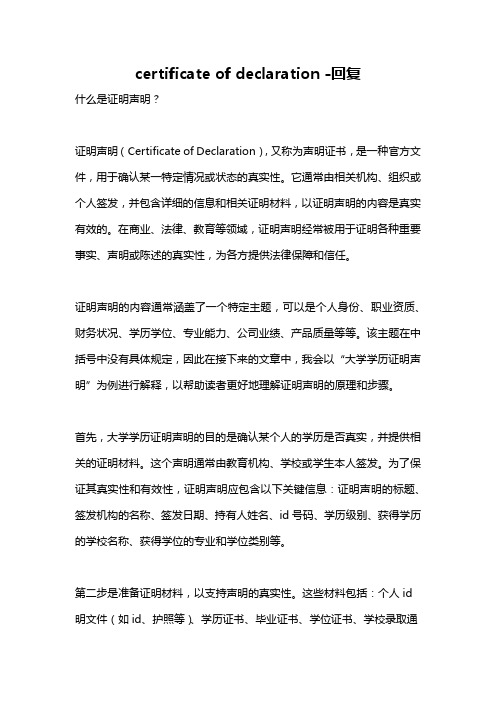
certificate of declaration -回复什么是证明声明?证明声明(Certificate of Declaration),又称为声明证书,是一种官方文件,用于确认某一特定情况或状态的真实性。
它通常由相关机构、组织或个人签发,并包含详细的信息和相关证明材料,以证明声明的内容是真实有效的。
在商业、法律、教育等领域,证明声明经常被用于证明各种重要事实、声明或陈述的真实性,为各方提供法律保障和信任。
证明声明的内容通常涵盖了一个特定主题,可以是个人身份、职业资质、财务状况、学历学位、专业能力、公司业绩、产品质量等等。
该主题在中括号中没有具体规定,因此在接下来的文章中,我会以“大学学历证明声明”为例进行解释,以帮助读者更好地理解证明声明的原理和步骤。
首先,大学学历证明声明的目的是确认某个人的学历是否真实,并提供相关的证明材料。
这个声明通常由教育机构、学校或学生本人签发。
为了保证其真实性和有效性,证明声明应包含以下关键信息:证明声明的标题、签发机构的名称、签发日期、持有人姓名、id号码、学历级别、获得学历的学校名称、获得学位的专业和学位类别等。
第二步是准备证明材料,以支持声明的真实性。
这些材料包括:个人id 明文件(如id、护照等)、学历证书、毕业证书、学位证书、学校录取通知书、在校成绩单、学校教育部门或学生事务办公室签发的学籍证明信等。
这些材料应该是原件或经过认证过的复印件,以确保其有效性和真实性。
第三步是填写证明声明的内容。
在证明声明的正文部分,应详细陈述持有人的个人信息和学历相关信息,确认其学历的真实性,并确保所填写的内容与提供的证明材料相匹配。
签发人应在声明的底部签字,并注明签发日期。
如果是由学校签发的证明声明,那么学校的公章和校长签名也应该有。
第四步是对证明声明和相关证明材料进行复核和核实。
签发人应认真检查证明声明的内容和附带材料,确保其准确性和真实性。
此外,签发人还应注意核对学历证书和其他证明文件的编号、日期和学校的公章,以确定这些文件的合法性。
3GPP 5G基站(BS)R16版本一致性测试英文原版(3GPP TS 38.141-1)
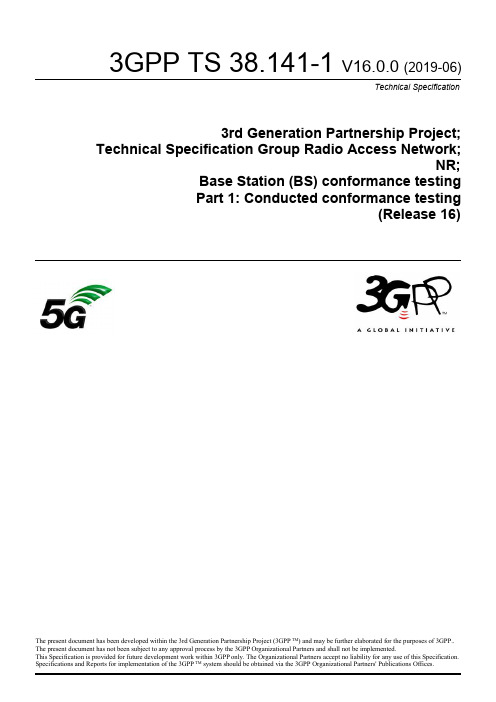
4.2.2
BS type 1-H.................................................................................................................................................. 26
4.3
Base station classes............................................................................................................................................27
1 Scope.......................................................................................................................................................13
All rights reserved. UMTS™ is a Trade Mark of ETSI registered for the benefit of its members 3GPP™ is a Trade Mark of ETSI registered for the benefit of its Members and of the 3GPP Organizational Partners LTE™ is a Trade Mark of ETSI registered for the benefit of its Members and of the 3GPP Organizational Partners GSM® and the GSM logo are registered and owned by the GSM Association
PriorNotificationandFailuretoPresent
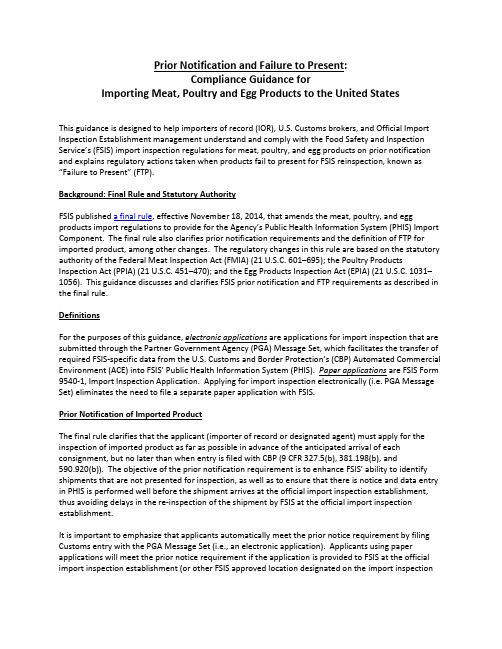
Prior Notification and Failure to Present:Compliance Guidance forImporting Meat, Poultry and Egg Products to the United StatesThis guidance is designed to help importers of record (IOR), U.S. Customs brokers, and Official Import Inspection Establishment management understand and comply with the Food Safety and Inspection Service’s (FSIS) import inspection regulations for meat, poultry, and egg products on prior notification and explains regulatory actions taken when products fail to present for FSIS reinspection, known as “Failure to Present” (FTP).Background: Final Rule and Statutory AuthorityFSIS published a final rule, effective November 18, 2014, that amends the meat, poultry, and egg products import regulations to provide for the Agency’s Public Health Information System (PHIS) Import Component. The final rule also clarifies prior notification requirements and the definition of FTP for imported product, among other changes. The regulatory changes in this rule are based on the statutory authority of the Federal Meat Inspection Act (FMIA) (21 U.S.C. 601–695); the Poultry Products Inspection Act (PPIA) (21 U.S.C. 451–470); and the Egg Products Inspection Act (EPIA) (21 U.S.C. 1031–1056). This guidance discusses and clarifies FSIS prior notification and FTP requirements as described in the final rule.DefinitionsFor the purposes of this guidance, electronic applications are applications for import inspection that are submitted through the Partner Government Agency (PGA) Message Set, which facilitates the transfer of required FSIS-specific data from the U.S. Customs and Border Protection’s (CBP) Automated Commercial Environment (ACE) into FSIS’ Public Health Information System (PHIS). Paper applications are FSIS Form 9540-1, Import Inspection Application. Applying for import inspection electronically (i.e. PGA Message Set) eliminates the need to file a separate paper application with FSIS.Prior Notification of Imported ProductThe final rule clarifies that the applicant (importer of record or designated agent) must apply for the inspection of imported product as far as possible in advance of the anticipated arrival of each consignment, but no later than when entry is filed with CBP (9 CFR 327.5(b), 381.198(b), and590.920(b)). The objective of the prior notification requirement is to enhance FSIS’ ability to identify shipments that are not presented for inspection, as well as to ensure that there is notice and data entry in PHIS is performed well before the shipment arrives at the official import inspection establishment, thus avoiding delays in the re-inspection of the shipment by FSIS at the official import inspection establishment.It is important to emphasize that applicants automatically meet the prior notice requirement by filing Customs entry with the PGA Message Set (i.e., an electronic application). Applicants using paper applications will meet the prior notice requirement if the application is provided to FSIS at the official import inspection establishment (or other FSIS approved location designated on the import inspectionapplication)as early as possible, but no later than when entry is filed with CBP).Of note, FSIS has revised the import inspection application (FSIS Form 9540-1) to include egg products and additional required information, such as production dates, and whether and when a country, foreign establishment, or specific product has been delisted or relisted as eligible for export. This information will help FSIS to verify that the relevant product was produced in the foreign establishment during an eligible timeframe. FSIS announced in the final rule that importers and brokers that do not use the PGA Message Set are to transition from the current FSIS Form 9540-1 (Import Inspection Application and Report) to the revised FSIS Form 9540-1 (Import Inspection Application) no later than March 18, 2015. The revised FSIS Form 9540-1 completed by the importer or broker must be correct. Table 1: Options and Requirements for Import Inspection ApplicationMode of CBP Entry ForeignInspectionCertificate Type Paper ForeignInspectionCertificaterequired?Paper 9540-1required?Prior notificationmet?ACE/Automated Commercial System (ACS) Entry Paper Yes Yes Yes, if paper 9540-1received no laterthan when entryfiled with CBPACE/ACS Entry Electroniccertification(eCert) No Yes Yes, if paper 9540-1received no laterthan when entryfiled with CBPACE with PGAMessage SetPaper Yes No YesACE with PGAMessage SeteCert No No YesFailure to Present (FTP) ShipmentsImported meat, poultry, and egg product that has entered commerce without FSIS import reinspection violates the FMIA, the PPIA, or the EPIA, as well as the implementing regulations for each Act (9 CFR 327.6; 381.199; 590.925). The importer of record is responsible for any product identified as FTP. FSIS will likely request that importers of record recall FTP product. Imported meat, poultry, and egg products are considered “in-commerce” when they are off-loaded at a location other than the official import inspection establishment or other FSIS approved location designated on the import inspection application. The FTP product is no longer eligible for reinspection. Product still in the original shipping container may either be destroyed or returned to the country of origin. When a product has been identified as a FTP, FSIS will request, through CBP, a redelivery of the shipment and appropriate CBP penalties. As part of the Single Window initiative, FSIS is working with CBP to automate the redelivery process by December 2016, which will streamline enforcement of CBP redelivery requirements and meet the goals of Executive Order 13659. Customs has full authority to assess penalties and liquidated damages claims and to seize merchandise for violations of Customs or other laws enforced by the Customs Service. For more information about CBP redelivery requirements and penalties, pleasecontact CBP’s Office of Regulations and Rulings (/contact/international-trade-contacts).If any imported product identified as FTP has been removed from the original cartons or further processed, FSIS will initiate a regulatory control action on the product, including any further processed product that contains the FTP product, to ensure appropriate disposition (i.e., destruction).Prior Notification Q&As1.What action will FSIS take if a shipment is presented for reinspection and FSIS did not receive thepaper import inspection application in advance of the shipment’s arrival at the official importinspection establishment?Answer: FSIS inspection program personnel will first check the PHIS Import Component to determine whether the IOR made entry with CBP using the PGA message set. If the IOR submitted the entry using the PGA message set, FSIS will proceed with the reinspection. If the IOR did not submit the entry using the PGA message set, FSIS inspection program personnel will identify the shipment in PHIS as a “Prior Notification Violation.” In addition, FSIS personnel will notify the IOR through the official import inspection establishment management of the violation, and that if violations continue, future shipments that do not meet the prior notification requirement will likely be refused entry. FSIS inspection program personnel will document the discussion with establishment management in a Memorandum of Interview (MOI) and then proceed with reinspection unless otherwise directed by FSIS management. If the shipment is not rejected, and FSIS proceeds with reinspection, the importer may experience unnecessary delays in the import inspection process if it does not meet this requirement. For prior notification violations, FSIS will consider using outreach (e.g., education and communication) with the IOR to ensure that prior notice requirements are understood.2.Will there be allowances for legitimate, mitigating circumstances, e.g., when ACE is notoperational?Answer: Under the final rule, the applicant is required to submit an Import Inspection Application in advance of the shipment’s arrival, but no later than when the entry is filed with CBP (9 CFR 327.5, 381.198, 590.920). FSIS is committed to working through any ACE-to-PHIS Import Component data transfer problems to avoid any delays in completing reinspection.3.How will prior notification apply to those who apply for import inspection electronically via thePGA Message Set?Answer: Applying for FSIS import inspection electronically via the PGA Message Set will fulfill the prior notification requirement.4.How will prior notification apply to those who apply for import inspection with a paper-basedapplication?Answer: For those importers or brokers using the paper-based import inspection application (FSIS Form 9540-1), FSIS must receive the paper application as far as possible in advance of the anticipated arrival of the consignment at the official import inspection establishment (or other FSIS approved locationdesignated on the import inspection application), but no later than when the entry is filed with CBP (9 CFR 327.5(b), 381.198(b), and 590.920(b)).5.How can I learn more about participating in the PGA Message Set? What kind of software orother upgrades do I need?Answer: More information can be found in CBP’s Federal Register Notice on the PGA Message Set. Regarding technical requirements, please consult CBP’s website on ACE Automated Broker Interface (ABI) and CBP and Trade Automated Interface Requirements (CATAIR). FSIS will expand its PGA Message Set pilot to include all ports, as well as all interested importers and brokers by November 2015).Failure to Present (FTP) Q&As6.How does FSIS define “in-commerce” for purposes of imported product that has bypassedreinspection and entered commerce?Answer: Imported meat, poultry, and egg products are considered “in-commerce” when they are off-loaded at a location other than the official import inspection establishment or other FSIS approved location designated on the import inspection application. If the FTP product shipment is in-commerce, the imported product, or any product produced from the ineligible product, is subject to regulatory control action (i.e., FSIS would retain or detain the product if it is not returned to the importer of record), and FSIS may request that the importer of record recall the product.7.Is transporting and storing imported product at a U.S. warehouse prior to reinspectionconsidered a FTP?Answer: Yes. FSIS does not permit storing of imported meat, poultry, or egg products in a warehouse or other facility prior to reinspection unless the warehouse or facility has the same physical address as the official import inspection establishment (or other FSIS-approved location designated on the import inspection application), and it is physically connected to the establishment. Official import inspection establishment managers can notify FSIS import inspection personnel of the shipment’s arrival to such a warehouse or facility, so that the status of the shipment can be changed to “On Premises” in the PHIS Import Component so as not to be identified as FTP.8.Will FSIS alert importers/agents to potential FTP product problems as soon as they arediscovered?Answer: Yes. FSIS inspection program personnel are instructed in FSIS Directive 9900.1 to notify the applicant electronically (e-mail) through the PHIS Import Component when a shipment has not arrived at the official import inspection establishment or other FSIS-approved location designated on the import inspection application by the Estimated Date of Arrival (EDA) recorded on the import inspection application. When prompted, PHIS will automatically send the e-mail to the applicant e-mail address entered on the Import Inspection Application, which is completed by the IOR or his agent. FSIS will communicate and work with import inspection establishment management to track and control potential FTPs.9.Can FTP products be re-exported or removed from the U.S?Answer: If the product is still in its original containers it may be removed from the United States and returned to the country of origin as part of the disposition process with FSIS. However, FSIS cannot issue an FSIS export certificate for imported product subject to a FTP violation.Reference LinksFederal Register Final Rule on Electronic Import Inspection Application:Electronic Import Inspection Application and Certification of Imported Products and Foreign Establishments; Amendments To Facilitate the Public Health Information System (PHIS) and Other Changes to Import Inspection Regulations (Sep 19, 2014)FSIS Federal Register Notice on PGA Message Set Pilot Program:Electronic Filing of Import Inspection Applications for Meat, Poultry, and Egg Products: Availability of Draft Compliance Guide and PGA Message Set Pilot Program (Mar 29, 2013)Electronic Import Inspection Application (FSIS Form 9540-1) Guideline:Data Samples and Guidelines for Using the PGA Message Set for Electronic Completion of the U.S. Department of Agriculture, Food Safety Inspection Service Application for Import Inspection (Aug 2013) PHIS Import Component: Public Health Information System (PHIS)-Import Component Home Page askFSIS: 。
开航前检查(新)
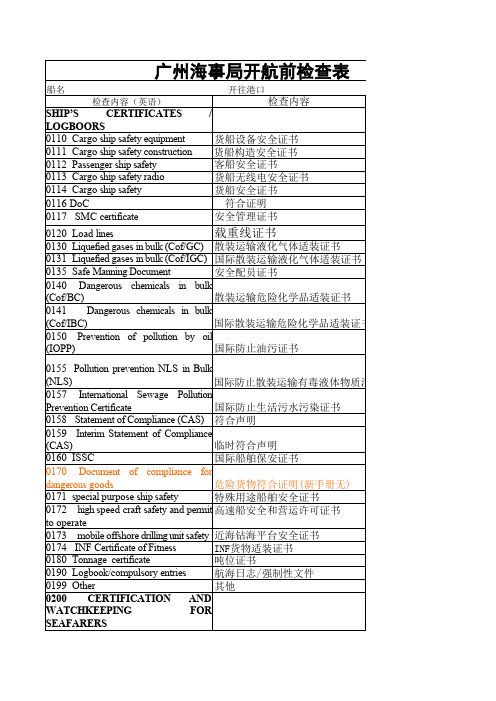
机械
0543 Steam pipes and pressure pipes 蒸汽管路与高压管路
0550 Danger areas
危险区域
0551 Gas instruments
气动工具
0552 Emergency cleaning devices 0599 Other 0600 LIFE SAVING APPLIANCE 0610 Lifeboats 0611 Lifeboat inventory 0613 Stowage of lifeboats 0615 Rescue boats 0616 Rescue boats inventory
冷藏室温度
0442 Cold room cleanliness
冷藏室清洁
0450 Food personnel hygiene
食品人员卫生
0451 Food temperature
食品温度
0452 Food segregation
食品分类隔离
0460 Record of inspection
检查记录
不干净、寄生虫 通风 供暖 噪声 卫生设施 排水 照明 管路、线缆(绝缘) 电器 病房
0371 Medical equipment
医疗设备
0380 Access/Structure
通道/结构
0382 Sleeping room
卧室
0383 No direct openings into sleeping
救助艇登乘装置
0684 Means of recovery of life-saving
appliances
救生设备回收手段
0686 Buoyant apparatus
TE Connectivity DTM系列连接器系统说明说明书
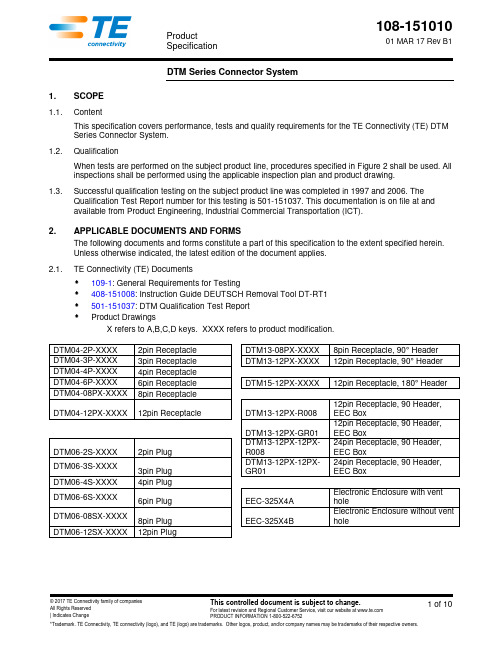
1 of 10© 2017 TE Connectivity family of companies All Rights Reserved | Indicates ChangeThis controlled document is subject to change.For latest revision and Regional Customer Service, visit our website at 1.1.ContentThis specification covers performance, tests and quality requirements for the TE Connectivity (TE) DTM Series Connector System.1.2. QualificationWhen tests are performed on the subject product line, procedures specified in Figure 2 shall be used. All inspections shall be performed using the applicable inspection plan and product drawing.1.3.Successful qualification testing on the subject product line was completed in 1997 and 2006. The Qualification Test Report number for this testing is 501-151037. This documentation is on file at and available from Product Engineering, Industrial Commercial Transportation (ICT).2. APPLICABLE DOCUMENTS AND FORMSThe following documents and forms constitute a part of this specification to the extent specified herein. Unless otherwise indicated, the latest edition of the document applies.2.1.TE Connectivity (TE) Documents109-1: General Requirements for Testing408-151008: Instruction Guide DEUTSCH Removal Tool DT-RT1 501-151037: DTM Qualification Test ReportProduct DrawingsX refers to A,B,C,D keys. XXXX refers to product modification.Wedge Lock PN's sold separately but are required for DTM functionality2.2.Industry DocumentsDIN 40050-9: Road Vehicles Degrees of protection (IP Code)DIN 72551-6: Road Vehicles —Low-Tension Cables —Part 6: Single-Core, Unscreened with ThinInsulation Wall; Dimensions, Materials, MarkingEIA-364: Electrical Connector/Socket Test Procedures Including Environmental Classifications IEC-60512: Electronic Equipment - Tests and MeasurementsIEC-60512-3: Electromechanical Components For Electronic Equipment: Basic Testing ProceduresAnd Measuring Methods - Part 3: Current- Carrying Capacity TestsIEC-60512-5-2: Connectors for equipment-Test and measurements-Part 5-2: Current-carryingcapacity tests-Test 5b: Current-temperature derating IEC-60529: Degrees of protection Provided by Enclosures (IP Code)ISO 6722: Road Vehicles —60 V and 600 V Single-Core Cables —Dimensions, Test Methods, andRequirements ISO 8092-2: C onnections for on-board Electrical Wiring Harness Part 2: Definitions, Test Methods and General Performance Requirements ISO 16750-3: Road Vehicles-Environmental Conditions and Testing for Electrical and Electronic Equipment Part 3: Mechanical Loads ISO 16750-4: Road Vehicles-Environmental Conditions and Testing for Electrical and Electronic Equipment Part 4: Climatic Loads SAE J1128: Low Voltage Primary CableSAE J2030: Heavy-Duty Electrical Connector Performance Standard3.REQUIREMENTS3.1.Design and ConstructionProduct shall be of the design, construction, materials and physical dimensions specified on the applicable product drawing.3.2. RatingsVoltage: 250 VDCTemperature: -55°C to +125°CIngress Protection (IP) Inline: IP68 and IP6K9K (with rear protection, such as backshell) Ingress Protection (IP) EEC Box: IP67 and IP6K9K (with rear protection on plugs, such as backshell)Flammability: UL Recognized. Parts have been successfully tested to the 20 mm Flame Test perStandard UL-943.3. Test Requirements and Procedures SummaryUnless otherwise specified, all tests shall be performed at ambient environmental conditions.The housing locking device shall withstand a constant force of 100N for 10 seconds.Test Current first 3-hours each axis:Test duration is 94-hours per axisISO 16750-3Three shocks are applied along the three mutually perpendicular axis for a total of 18 shock. The pulse shall be approximately half sine wave of 300g magnitude with a duration of 3 msISO 8092-2The length of the cable shall be 1250mm long. Attach the cable to a fixed pointCycle mated connectors from –55°C to+125°C. Connectors to remain at each temperature extreme for one (1) hour minimum. Mated connectors are to be cycled a total of 20 complete cycles.SAE J2030Subjected test sample to 10 cycles. One cycle shall consist of a soak time at –then a transition within 2 min to an ambientNOTEa) All cavities wired with the minimum approved wire gauge per SAE J1128 suitable forthe terminal size and with sufficient length to accommodate testing. Wire insulationshall be minimum diameter per SAE J1128 and shall be verified to be within theconnector wire sealing range. Crimp characteristics (i.e. height, width, etc.) shall bechecked prior to testing.All unsealed cavities shall be secured with sealing plugs. To prevent capillary action on the sealed connector, all free wire ends and test points (i.e. millivolt test connection)shall be sealed with alcohol-based RTV silicone or equivalent and covered with heatshrink tubing.b) Specimens shall be prepared in accordance with applicable production drawings andshall be selected at random from current production.3.4. Product Qualification and Requalification Test SequenceNOTE(a) Specimens shall be prepared in accordance with applicable Instruction Sheets and shall beselected at random form current production.a. Groups 1-3. Specimens shall consist of 12 position connectors with DEUTSCH SolidTerminal System size 20 nickel and gold pin and socket contacts with 18, 20 AWG.b. Group 4. Specimens shall consist of 2 and 12 position connectors with DEUTSH SolidTerminal System size 20 nickel pin and socket contacts with 20 AWG.c. Groups 5-14. Specimens shall consist of 2, 3, 4, 6, 8 and 12 position connectors withDEUTSCH Stamped & Formed Terminal System size 20 nickel pin and socket contactswith 0.50mm2, 0.75mm2 and 1.50mm2d. Groups 15-17. Specimens shall consist of 2, 3, 4, 6, 8 and 12 position connectors withDEUTSCH Stamped & Formed Terminal System size 20 nickel pin and socket contactswith 20 AWG.(b) Numbers indicate sequence in which tests are performed.3.5. Appendix ATest Procedure Comparison Chart。
驻留类化妆品中镉和汞的监测结果及健康风险评估
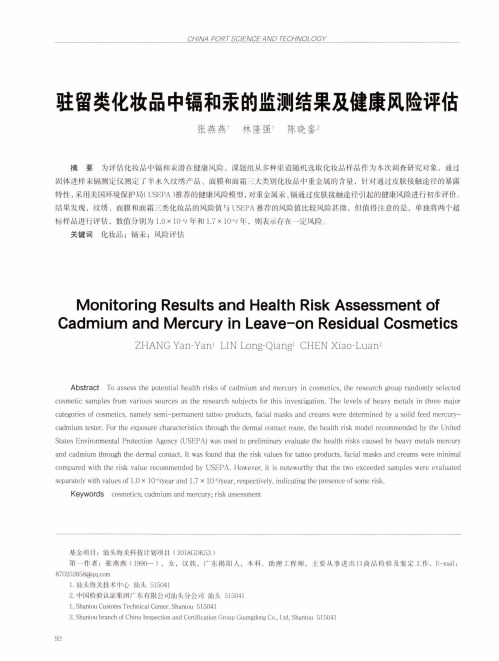
驻留类化妆品中镉和汞的监测结果及健康风险评估张燕燕1林隆强1陈晓銮*12摘要为评估化妆品中镉和汞潜在健康风险,课题组从多种渠道随机选取化妆品样品作为本次调查研究对象,通过 固体进样汞镉测定仪测定了半永久纹绣产品、面膜和面霜三大类别化妆品中重金属的含量,针对通过皮肤接触途径的暴露 特性,采用美国环境保护局(U S E P A )推荐的健康风险模型,对重金属汞、镉通过皮肤接触途径引起的健康风险进行初步评价。
结果发现,纹绣、面膜和面霜三类化妆品的风险值与U S E P A推荐的风险值比较风险甚微,但值得注意的是,单独将两个超 标样品进行评估,数值分别为1.0 x 10A年和1.7 x 1C H/年,则表示存在一定风险。
关键词化妆品;镉汞;风险评估Monitoring Results and Health Risk Assessment of Cadmium and Mercury in Leave-on Residual Cosmetics ZHANG Yan-Yan1LIN Long-Qiang1CHEN Xiao-Luan2A b s tra c t T o assess the potential health risks of c a d m i u m and mercury in cosmetics, the research group randomly selected cosmetic samples from various sources as the research subjects for this investigation. T h e levels of heavy metals in three major categories of cosmetics, namely semi-permanent tattoo products, facial m a sks a nd creams were determined by a solid feed mercury- c a d m i u m tester. For the exposure characteristics through the dermal contact route, the health risk model r e c o m m e n d e d by the United States Environmental Protection A g e n c y (U S E P A) w as used to preliminary evaluate the health risks caused by heavy metals mercury and c a d m i u m through the dermal contact. I t was found that the risk values for tattoo products, facial m a s k s and creams were minimal c o m p a r e d with the risk value r e c o m m e n d e d by U S E P A.However, i t i s noteworthy that the two exceeded samples were evaluated separately with values of 1.0 x lO-^/year and 1.7 x lO^/year, respectively, indicating the presence of s o m e risk.K e y w o rd s cosmetics;c a d m i u m and mercury; risk assessment基金项目:汕头海关科技计划项目(2018G D K53)第一作者:张燕燕(1990—),女,汉族,广东揭阳人,本科,助理工程师,主要从事进出口商品检验及鉴定工作,E-mail: 870252858@qq .com1. 汕头海关技术中心汕头5150412.中国检验认证集团广东有限公司汕头分公司汕头5150411. Shantou Customs Technical Center, Shantou 5150412. Shantou branch of China Inspection and Certification Group Guangdong Co., Ltd, Shantou 51504192随着人们生活水平不断提高,消费者对化妆品给 予了前所未有的关注。
certificate of declaration -回复
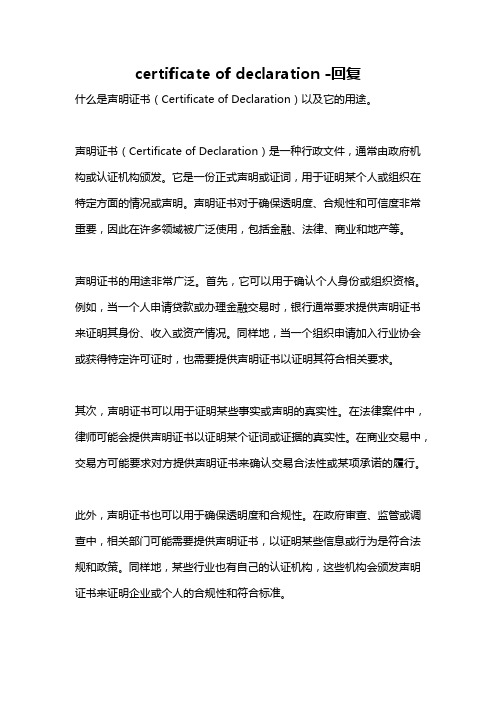
certificate of declaration -回复什么是声明证书(Certificate of Declaration)以及它的用途。
声明证书(Certificate of Declaration)是一种行政文件,通常由政府机构或认证机构颁发。
它是一份正式声明或证词,用于证明某个人或组织在特定方面的情况或声明。
声明证书对于确保透明度、合规性和可信度非常重要,因此在许多领域被广泛使用,包括金融、法律、商业和地产等。
声明证书的用途非常广泛。
首先,它可以用于确认个人身份或组织资格。
例如,当一个人申请贷款或办理金融交易时,银行通常要求提供声明证书来证明其身份、收入或资产情况。
同样地,当一个组织申请加入行业协会或获得特定许可证时,也需要提供声明证书以证明其符合相关要求。
其次,声明证书可以用于证明某些事实或声明的真实性。
在法律案件中,律师可能会提供声明证书以证明某个证词或证据的真实性。
在商业交易中,交易方可能要求对方提供声明证书来确认交易合法性或某项承诺的履行。
此外,声明证书也可以用于确保透明度和合规性。
在政府审查、监管或调查中,相关部门可能需要提供声明证书,以证明某些信息或行为是符合法规和政策。
同样地,某些行业也有自己的认证机构,这些机构会颁发声明证书来证明企业或个人的合规性和符合标准。
那么,如何获得声明证书呢?首先,申请人需要了解需要获得声明证书的具体要求和程序。
不同的机构或部门可能有不同的要求和程序,因此申请人需要仔细阅读相关的指南或条例,以确保按所需程序进行申请。
其次,申请人需要提供详细和准确的信息。
通常,声明证书需要提供个人或企业的基本信息,如姓名、地址、联系方式等。
此外,申请人还需要提供与所需声明相关的具体信息,例如收入、资产情况等。
接下来,申请人可能需要进行验证或审查。
这可能包括检查申请人提供的文件、调查相关背景或联系申请人的参考人。
这一步骤旨在确保申请人提供的信息和声明的真实性和准确性。
job submitter lic error -回复
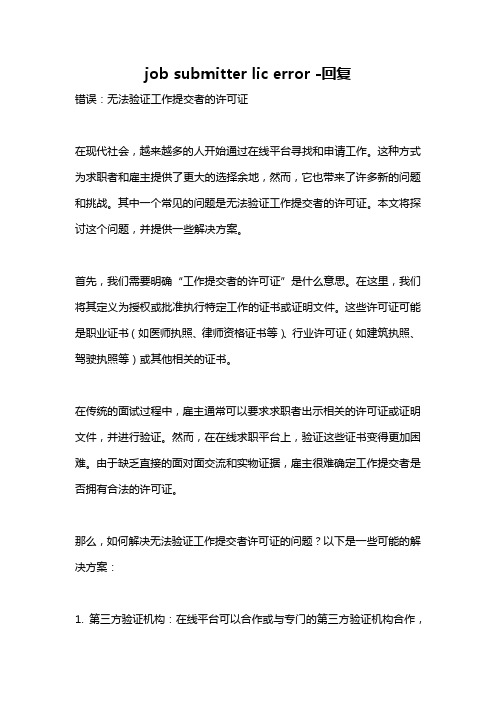
job submitter lic error -回复错误:无法验证工作提交者的许可证在现代社会,越来越多的人开始通过在线平台寻找和申请工作。
这种方式为求职者和雇主提供了更大的选择余地,然而,它也带来了许多新的问题和挑战。
其中一个常见的问题是无法验证工作提交者的许可证。
本文将探讨这个问题,并提供一些解决方案。
首先,我们需要明确“工作提交者的许可证”是什么意思。
在这里,我们将其定义为授权或批准执行特定工作的证书或证明文件。
这些许可证可能是职业证书(如医师执照、律师资格证书等)、行业许可证(如建筑执照、驾驶执照等)或其他相关的证书。
在传统的面试过程中,雇主通常可以要求求职者出示相关的许可证或证明文件,并进行验证。
然而,在在线求职平台上,验证这些证书变得更加困难。
由于缺乏直接的面对面交流和实物证据,雇主很难确定工作提交者是否拥有合法的许可证。
那么,如何解决无法验证工作提交者许可证的问题?以下是一些可能的解决方案:1. 第三方验证机构:在线平台可以合作或与专门的第三方验证机构合作,以验证工作提交者的许可证。
这些验证机构可以通过与相关的监管机构联系,获取和验证工作提交者的证书信息。
2. 线上认证系统:在线平台可以开发自己的认证系统,允许工作提交者上传和验证其许可证或证明文件。
这些系统可以使用技术手段,如图像识别、文本匹配等,来验证证书的真实性。
3. 用户评价和反馈:在线平台可以引入用户评价和反馈机制,让其他雇主和用户评价他们曾经合作过的工作提交者。
通过这种方式,用户可以根据其他人的评价来判断工作提交者的能力和信任度。
4. 实名制:在线平台可以要求工作提交者提供真实的身份信息,包括姓名、联系方式、id件等。
这样做可以增加平台上用户的真实性和可信度。
然而,这些解决方案也存在一些挑战和限制。
例如,第三方验证机构可能无法获得所有国家和行业的许可证信息,并且可能需要长时间来完成验证过程。
线上认证系统可能面临技术上的困难,例如防止伪造证书和确认证书的有效性。
Bartender发布到服务器出现CLSID为{B9425246-4131-11D2-BE。。。
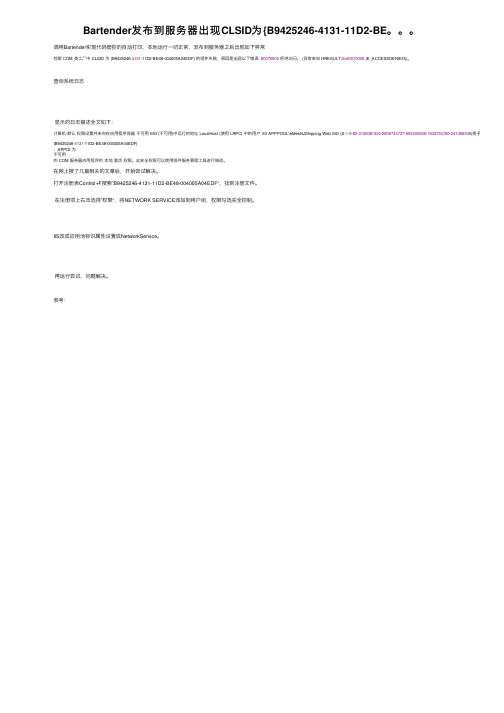
Bartender发布到服务器出现CLSID为{B9425246-4131-11D2-BE。
调⽤Bartender实现代码管控的⾃动打印,本地运⾏⼀切正常,发布到服务器之后出现如下异常
检索 COM 类⼯⼚中 CLSID 为 {B9425246-4131-11D2-BE48-004005A04EDF} 的组件失败,原因是出现以下错误: 80070005拒绝访问。
(异常来⾃ HRESULT:0x80070005 (E_ACCESSDENIED))。
查询系统⽇志
显⽰的⽇志描述全⽂如下:
计算机-默认权限设置并未向在应⽤程序容器不可⽤ SID (不可⽤)中运⾏的地址 LocalHost (使⽤ LRPC) 中的⽤户 IIS APPPOOL\eMesNJShipping.Web SID (S-1-5-82-3156081320-2806744727-693200556-1633734760-241366336)授予针对 CLSID 为{B9425246-4131-11D2-BE48-004005A04EDF}
、APPID 为
不可⽤
的 COM 服务器应⽤程序的本地激活权限。
此安全权限可以使⽤组件服务管理⼯具进⾏修改。
在⽹上搜了⼏篇相关的⽂章后,开始尝试解决。
打开注册表Control+F搜索”B9425246-4131-11D2-BE48-004005A04EDF“,找到注册⽂件。
在注册项上右击选择”权限“,将NETWORK SERVICE添加到⽤户组,权限勾选完全控制。
IIS改成应⽤池标识属性设置成NetworkService。
再运⾏尝试,问题解决。
参考:。
使用证书编译 -回复
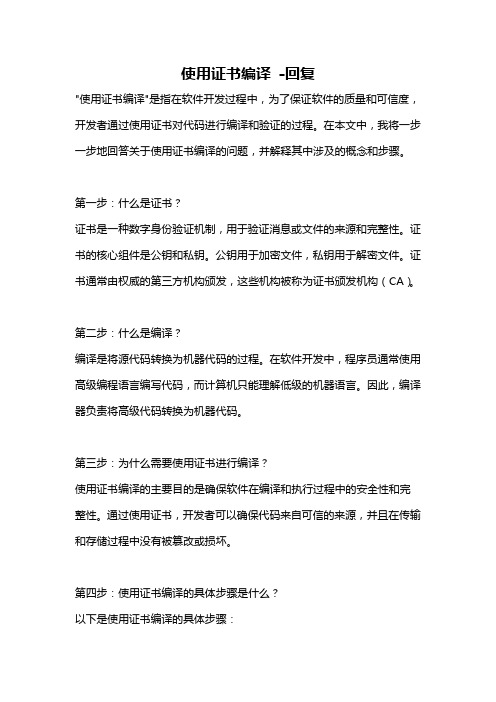
使用证书编译-回复"使用证书编译"是指在软件开发过程中,为了保证软件的质量和可信度,开发者通过使用证书对代码进行编译和验证的过程。
在本文中,我将一步一步地回答关于使用证书编译的问题,并解释其中涉及的概念和步骤。
第一步:什么是证书?证书是一种数字身份验证机制,用于验证消息或文件的来源和完整性。
证书的核心组件是公钥和私钥。
公钥用于加密文件,私钥用于解密文件。
证书通常由权威的第三方机构颁发,这些机构被称为证书颁发机构(CA)。
第二步:什么是编译?编译是将源代码转换为机器代码的过程。
在软件开发中,程序员通常使用高级编程语言编写代码,而计算机只能理解低级的机器语言。
因此,编译器负责将高级代码转换为机器代码。
第三步:为什么需要使用证书进行编译?使用证书编译的主要目的是确保软件在编译和执行过程中的安全性和完整性。
通过使用证书,开发者可以确保代码来自可信的来源,并且在传输和存储过程中没有被篡改或损坏。
第四步:使用证书编译的具体步骤是什么?以下是使用证书编译的具体步骤:1. 获取开发者证书:开发者需要在证书颁发机构注册,并申请开发者证书。
开发者证书包含了开发者的公钥和相关信息。
2. 给软件添加数字签名:在编译软件之前,开发者需要使用自己的私钥对软件进行数字签名。
数字签名可以确保软件的完整性和来源可信度。
数字签名的过程包括使用私钥对哈希值进行加密,并将这个加密值与软件一起发布。
3. 审核和验证证书:在编译软件时,开发者通过验证开发者证书来确保代码的可信度和完整性。
验证过程包括检查证书的有效性、颁发机构的可信度以及证书的吊销状态。
4. 编译软件:一旦开发者通过验证了证书,就可以开始编译软件了。
开发者使用编译器将源代码转换为机器代码,并将数字签名的加密值添加到可执行文件中。
5. 部署和使用:编译完成的软件可以部署和使用了。
用户可以在他们的设备上安装软件,并通过验证数字签名来确认软件的来源和完整性。
总结:使用证书编译是软件开发过程中确保代码安全和可信度的关键步骤。
- 1、下载文档前请自行甄别文档内容的完整性,平台不提供额外的编辑、内容补充、找答案等附加服务。
- 2、"仅部分预览"的文档,不可在线预览部分如存在完整性等问题,可反馈申请退款(可完整预览的文档不适用该条件!)。
- 3、如文档侵犯您的权益,请联系客服反馈,我们会尽快为您处理(人工客服工作时间:9:00-18:30)。
1.
申请人姓名
电话:
地址:
电话:
电话:
城市:
省
邮件:传真:
2.如果您当前或以前认证过CSA 标准W178.2,请提供您的注册号:
3.期望认证级别:(请参阅下面的各级别经验要求)
3.1
一级
二级
三级
3.2
4.
5.认证费
长考试
短考试
批准人:
日期:
W178.2
焊接检验员认证申请
重要说明: 申请表务必填写完整,不完整的申请表将造成处理延误并可能被退回给申请人。
填写完成后,请将此表的提交给最近的加拿大焊接协会办事处(参见末页的各地区办事处地址),并自行保留副本。
名
姓
居住地
街道
办公
邮编
国家
手机
最低焊接或检验工作年限要求如下:
(a) 对于一级认证,申请人应当在CSA 标准W178.2第9.1.2条规定的一个或更多领域拥有至少一年的工作经验,或者顺利通过焊接基本理论与实践操作、质量控制和焊接检验的考试。
(b) 对于二级认证,申请人应当拥有至少两年的一级焊接检验员工作经验。
(c) 对于三级认证,申请人应当拥有至少四年的二级焊接检验员工作经验。
(d) 在特殊情况下,实习焊接检查员可以有资格直接晋级为二级或三级。
在这种情况下,申请人应证明其所受的教育、培训和工作经验经验等效于二级或三级。
所有申请认证的申请人必须在申请之日起一年内顺利通过其申请等级的全部考试内容,否则其认证申请将被终止。
如果适用,在下表填写你已经顺利完成的认证培训课程,包括焊接的基本理论与实践操作、质量控制和焊接检验。
机构名称课程或研究项目名称
开始日期(MM / YYYY)完成日期(MM / YYYY)
课程或项目的总月数
认证费包含相应的税费,应在提交认证申请表时支付。
未缴费的申请将不会被处理。
认证费可在支付日起三十日内退款,但需扣除服务费。
不符合条件的申请人将在扣除服务费后退还全部费用。
日期
申请人签名
MM / DD / YYYY
认证请求完成后,你是否希望将你的姓名、认证等级、居住城市和电话号码公布到加拿大焊接协会的官方网站上?仅供加拿大焊接协会填写
注册编号:
等级:
否
是
1
1.Applicant's Name:
Tel.:
Address:Tel.:
Tel.:
City:
Province
Email:Fax:
2.If you are currently or were previously certified to CSA Standard W178.2 , provide your Registration Number:
3.Level of Certification Desired: (See experience requirements for each level below)
3.1
Level 1
Level 2
Level 3
3.2
4.
5.Certification Fee
Long Exam
Short Exam
Approved By:
Date:
TOTAL # OF MONTHS FOR COURSE OR PROGRAM
W178.2
Street
Applicant's Signature
The certification fee including applicable tax is payable upon submission of the application form.Applications received without the fee will not be processed.The fee,less a service charge,is refundable only within 30days from receipt of payment.Candidates who are not eligible will be refunded the full fee less a service charge.
DATE
Level:
Upon completion of the certification requirements, do you wish to have your name, certification level, city of residence and telephone
number published on the CWB Group's website?Reg. No.
FOR CWB USE ONLY
NAME OF INSTITUTION
Middle Name
If applicable, identify recognized training courses in the Fundamental Principles and Practices of Welding and Quality Control and Inspection of Welding that you have successfully completed.
DATE COMPLETED (MM / YYYY)
IMPORTANT:Applications MUST be completed in full.Incomplete applications can cause delays in processing and may be returned to the applicant.
Upon completion,please submit one copy of this form to the nearest office of the Canadian Welding Bureau (see region office addresses on the last page)and retain a copy for your file.
First Name
All candidates applying for certification must successfully complete the required examinations within one year from their application
date for certification in the desired level, otherwise their application for certification will be st Name
The minimum years of welding or inspection experience is as follows:
(a) For Level 1 certification, the candidate shall have obtained at least one year of experience in one or more of the areas specified in Clause 9.1.2 of CSA Standard W178.2; or successfully completed recognized courses in the fundamental principles and practices of welding, quality control, and welding inspection.
(b) For Level 2 certification, the candidate shall have at least two years of experience as a certified Level 1 welding inspector.(c) For Level 3 certification, the candidate shall have at least four years of experience as a certified Level 2 welding inspector.(d) In exceptional cases, practicing welding inspectors may be eligible to qualify directly as Level 2 or Level 3. In such cases,
candidates shall demonstrate that their combination of education, training, and experience is equivalent to either Level 2 or Level 3.MM / DD / YYYY
APPLICATION FOR CERTIFICATION AS WELDING INSPECTOR
Country
Postal Code
Business
Cell
DATE STARTED (MM / YYYY)
NAME OF COURSE OR PROGRAM OF STUDY
Residence
NO YES。
